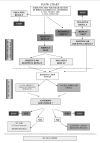A comparison of two automated methods for the detection and identification of red blood cell alloantibodies
- PMID: 19204749
- PMCID: PMC2535873
- DOI: 10.2450/2007.0022-06
A comparison of two automated methods for the detection and identification of red blood cell alloantibodies
Abstract
Background: The aim of this study was to compare the routine use of two automated systems (OrthoAutoVue Innova, microcolumn, and Immucor Galileo, solid phase) for the screening and identification of irregular red blood cell alloantibodies in samples, analysed in our Transfusion Service during 6 months of normal activity. The study focused particularly on an evaluation of the repeatability of the screening tests, the identification of antibody specificities and the identification of antibodies in samples showing discordant results.
Materials and methods: Overall 2,229 samples from potential blood donors (A), multiply transfused patients with blood disorders (DH), potential transfusion recipients (TS), and external cases (E) were studied. The protocols were carried out according to the manufacturers recommendations.
Results: The screening tests detected 78 samples that were positive with both systems, while 18 were positive only with Immucor and 11 only with Ortho (thus, overall, Immucor detected 96 positive samples and Ortho 89 positive samples). The use of the respective identification panels enabled us to identify the antibodies in 65 samples with Immucor and in 61 samples with the Ortho system; 74 antibodies were identified with Immucor (55 with a single specificity and 19 with mixed specificities) and 68 antibodies with Ortho (51 and 17, respectively). In the remaining cases (31 samples for Immucor and 28 for Ortho), the antibody specificity was not identified. The two systems were found to be essentially similar. The Immucor system revealed a greater number of antibodies, mainly because of its greater sensitivity at detecting anti-D antibodies.
Conclusions: Both systems showed a repeatability of over 85%, demonstrating that automation of immunohaematological tests is advantageous. The specificity of the antibody was identified in 68% of the samples. Furthermore, using the two systems led to the identification of ten new antibodies (6 anti-D, 2 anti-E, 1 anti Le(a), and 1 anti-Vel), which would not have been detected had only one of the two methods been used.
Keywords: antibody screening and identification; automated methods; red blood cell antibodies.
Similar articles
-
Prevalence of irregular red cell antibody in healthy blood donors attending a tertiary care hospital in North India.Asian J Transfus Sci. 2018 Jan-Jun;12(1):17-20. doi: 10.4103/ajts.AJTS_4_17. Asian J Transfus Sci. 2018. PMID: 29563670 Free PMC article.
-
Antibody identification using both automated solid-phase red cell adherence assay and a tube polyethylene glycol antiglobulin method.Transfusion. 2008 Aug;48(8):1693-8. doi: 10.1111/j.1537-2995.2008.01736.x. Epub 2008 May 13. Transfusion. 2008. PMID: 18482178
-
Frequencies and specificities of "enzyme-only" detected erythrocyte alloantibodies in patients hospitalized in austria: is an enzyme test required for routine red blood cell antibody screening?J Blood Transfus. 2014;2014:532919. doi: 10.1155/2014/532919. Epub 2014 Mar 25. J Blood Transfus. 2014. PMID: 24790773 Free PMC article.
-
Erythrocyte Alloimmunization and Autoimmunization among Blood Donors and Recipients visiting a Tertiary Care Hospital.J Clin Diagn Res. 2017 Mar;11(3):EC12-EC15. doi: 10.7860/JCDR/2017/22904.9401. Epub 2017 Mar 1. J Clin Diagn Res. 2017. PMID: 28511387 Free PMC article.
-
Evaluation of an automated microplate technique in the Galileo system for ABO and Rh(D) blood grouping.Clin Lab. 2014;60(2):241-4. doi: 10.7754/clin.lab.2013.121011. Clin Lab. 2014. PMID: 24660536
Cited by
-
Evaluation of Pre-Transfusion Crossmatch Test Using Microscanner C3.Diagnostics (Basel). 2024 Jun 12;14(12):1231. doi: 10.3390/diagnostics14121231. Diagnostics (Basel). 2024. PMID: 38928646 Free PMC article.
-
Comparison of two column agglutination tests for red blood cell antibody testing.PLoS One. 2018 Dec 31;13(12):e0210099. doi: 10.1371/journal.pone.0210099. eCollection 2018. PLoS One. 2018. PMID: 30596807 Free PMC article. Clinical Trial.
-
A rewarding fresh look at routine blood group data.Blood Transfus. 2008 Oct;6(4):182-3. doi: 10.2450/2008.0043-08. Blood Transfus. 2008. PMID: 19112731 Free PMC article. No abstract available.
-
A comparison of three column agglutination tests for red blood cell alloantibody identification.BMC Res Notes. 2020 Mar 4;13(1):129. doi: 10.1186/s13104-020-04974-x. BMC Res Notes. 2020. PMID: 32131887 Free PMC article.
References
-
- Molaro GL. L evoluzione tecnologica in immunoematologia eritrocitaria. The Ligand Quarterly. 1993;12:466–74.
-
- Bunker LB, Thomas CL, Geyer SJ. Optimizing pretransfusion antibody detection and identification: a parallel, blinded comparison of tube PEG, solid-phase, and automated methods. Transfusion. 2001;41:621–6. - PubMed
-
- Poole GD, Evans RG, Voak D, et al. Evaluation of six systems for the detection of red cell antibodies. In: Chapman J, Grgicevic D, Dubrovnik, editors. Quality Assurance in Transfusion Medicine; Proceedings of the ESTM residential course; 23–26 April 1998; pp. 153–200.
-
- Rossi D, Tasca R, Borzini P, et al. Indagine multicentrica sull opportunità di impiegare un panello eritrocitario recante antigeni rari nell ambito del Type and Screen (T&S), gel sedimentazione versus fase solida. Atti del XXXII Convegno Nazionale di Studi di Medicina Trasfusionale; Taormina. 25–29 May 1996; pp. 140–2.
-
- Stute R, Patek A. Comparison of three different methods of antibody screening and identification (P410). Proceedings of ISBT Congress; Paris. 15–18/07/2001.
LinkOut - more resources
Full Text Sources

